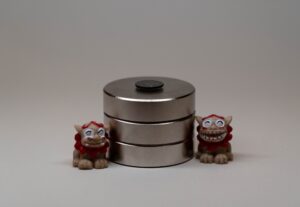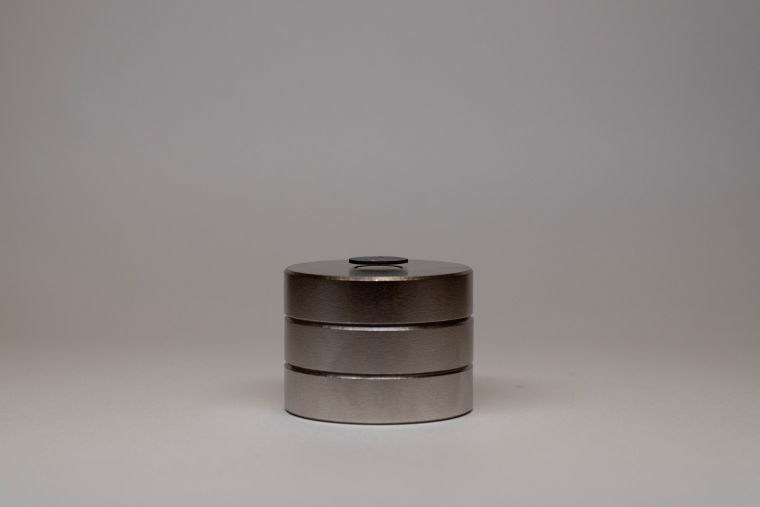Okinawa Institute of Science and Technology (OIST) scientists have achieved a levitation breakthrough by creating a virtually frictionless, macroscopic levitating disk, which requires no external power to magically float above a series of rare-earth magnets.
The researchers behind the historic achievement believe their levitating disk, which resists magnetic eddy forces that can reduce its sensitivity, could be adapted to sensors designed to measure extremely small forces. These include interactions of dark matter and dark energy, as well as those found in the quantum realm.
According to a statement announcing the latest levitation breakthrough, these microscale devices are “highly sensitive” to environmental factors, which can affect their accuracy and ability to operate. Conversely, they note that macroscale magnetic levitation systems that operate at room temperature are “simpler and much more resistant to the environment” since they react to gravity, unlike microscale systems that suspend atomic particles.
In theory, this makes these systems well-suited for experiments designed to measure gravitational effects and what the team described as “foundational research in the boundary between quantum and classical physics.” Still, these systems are limited by a magnetic effect known as eddy-current dampening.
For example, when conductive materials are moved further away from magnets, circulating magnetic currents of electrons called eddies form within the conductive material. The team notes that eddy currents can have practical benefits, such as those used in bullet trains and brakes for power tools. However, they note, if one wants to use a magnetically levitated rotor to measure physical phenomena, “this friction is problematic.
“This is particularly useful in the case of rotors, as their torque and angular momentum, used to measure gravity, gas pressure, momentum, among other phenomena in both classical and quantum physics, can be strongly influenced by friction,” they explain. “Freely suspending the rotor could drastically reduce these disturbances.”
The OSIT team had previously attempted to overcome this problem by creating a macroscale magnetic levitating square plate from graphite powder coated in silica and embedded in a layer of wax. The team said the wax medium was included to dampen the eddy currents, as they would be confined to the grains of graphite powder rather than the entire plate.
The final version “paved the way” for precision accelerometers, which can detect extremely small changes in gravity. The tea notes that a device using their design was recently launched into space as a proof of concept for the approach. In theory, the ODIT team said such a device operating in space could help study dark matter interactions and gravimetric waves “among other fundamental physics questions.”
Still, using the wax disk approach had its limitations. According to the researchers, the design significantly diminished the system’s overall levitating power, “making it less suitable for integration into other systems as added weight – such as from a mirror used to track its rotation – may disrupt it.”
 Shown for reference, the shisa (lion-dog) figurines are about 2 cm tall. Image Credit: Okinawa Institute of Science and Technology (OIST).
Shown for reference, the shisa (lion-dog) figurines are about 2 cm tall. Image Credit: Okinawa Institute of Science and Technology (OIST).
A New Path Toward Levitation Tech
Although magicians use tricks to give the illusion of objects levitating, scientists already use levitation to measure extremely minute forces. In the past, The Debrief has reported on how scientists use acoustic levitation and the benefits of electric levitation in sensing applications. Still, such levitation experiments often require expensive equipment and complicated setups, limiting how scientists can utilize the unique benefits of the phenomenon.
Hoping to improve on their current design, the team eliminated the wax and grains, creating an all-new levitating disk from pure graphite. The team said this design retained its strong levitating force and theoretically “does away with eddy-current damping entirely in an ideal system.”
“The plate design experiences slight eddy-current damping when moving up and down, because the magnetic strength – or flux – changes, forming eddy currents inside the silica-coated graphite grains,” explained Professor Jason Twamley, head of the unit and senior author on the study. “But a rotor remains in the same magnetic field when rotating around its central axis above magnets. It does not experience a change in flux – and this therefore eliminates eddy-current damping.”
After modelling the levitating disk’s properties in computer simulations, the researchers proved their approach mathematically. Once confident in their design, the team built the macroscale levitating disk without any external power source and with only four simple parts: three rare-earth magnets and the disk itself.
Although the design was a success, the team said the next steps to improve their system involve precision machining of the graphite plate and the magnets “to achieve ideal axial symmetry, and the reduction of air friction by getting as close to a perfect vacuum as possible.” With these adjustments, Prof. Twamley believes their macroscale levitating disk will be perfectly suited for extremely precise sensor designs that operate “at the scale of milli- instead of nanometers.”
“It can be spun up to serve as precise and reliable gyroscopes or spun down – cooled – into the quantum regime,” the researcher explained. “We’re particularly interested in the latter, as it’s a very promising platform for the study of quantum phenomena like vacuum gravity and rotational superposition at a macroscopic level.”
Daehee Kim, PhD student in the unit and first author on the paper, agreed, noting how a setup using only a one-centimeter graphite disk and a handful of rare earth magnets demonstrated both analytically and experimentally how to build a “diamagnetically levitating rotor” that does not experience any eddy currents due to the design’s axial symmetry.
“If we can slow its rotation enough, its motion will enter the quantum regime, which could open up an entirely new platform for quantum research,” Kim said.
The study “A magnetically levitated conducting rotor with ultra-low rotational damping circumventing eddy loss” was published in Communications Physics.
Christopher Plain is a Science Fiction and Fantasy novelist and Head Science Writer at The Debrief. Follow and connect with him on X, learn about his books at plainfiction.com, or email him directly at christopher@thedebrief.org.

